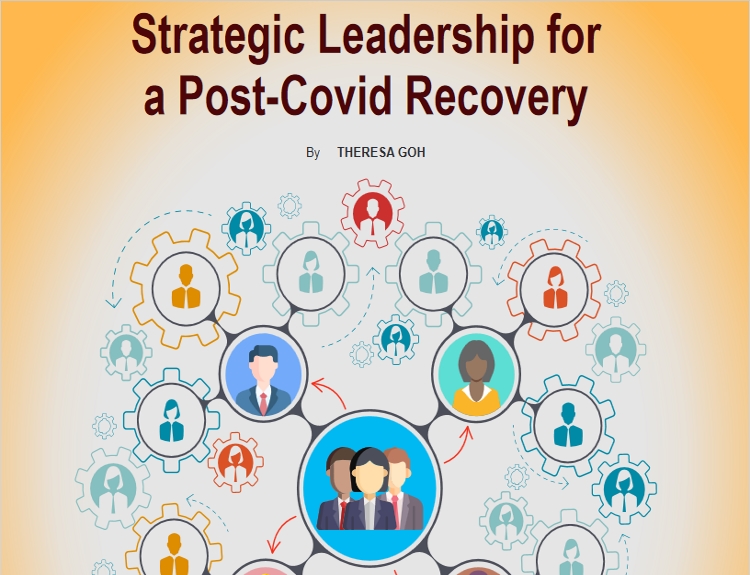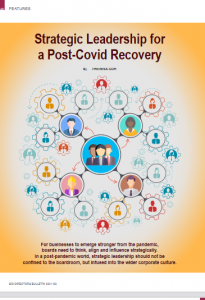For businesses to emerge stronger from the pandemic, boards need to think, align and influence strategically.
In a post-pandemic world, strategic leadership should not be confined to the boardroom, but infused into the wider corporate culture.
Strategic leadership refers to a leader’s ability to apply strategic thinking, aligning and influencing on a daily basis.
- Strategic thinking is the ability to set a longterm purposeful direction for the corporation amid complexities, ambiguities, and the connectedness of politics, economics, and societal progress.
- Strategic alignment is creating a plan that considers existing systems and structures to realise the corporate vision through specific, attainable goals.
- Strategic influencing is the act of motivating and persuading others to co-own the vision and plan, building commitment across boundaries, and fostering collaborative practices.
All these must be driven by strategic intent. This mindset focuses on creating human, knowledge, economic, and social capital to ethically exploit future opportunities that positively impact main stakeholders.
Strategic Behaviours
1. Think strategically.
- Understand and articulate complexities and priorities, and identify polarities.
- Learn about future trends, do scenario planning and imagine how to shape a better world for all stakeholders.
- Recognise opportunities for strategic leadership and find ways to overcome strategic leadership challenges collectively.
- Seize opportunities to test entirely new approaches.
- Welcome new ideas and debates, and challenge the status quo.
2. Align strategically.
- Take decisive and timely actions aligned with the rest of the organisation and consistent with the strategic direction.
- Constantly learn and call out areas of misalignment, even if it means going against the collective.
- Be willing to re-strategise as new learnings surface.
3. Influence strategically.
- Empower key stakeholders inside and outside the organisation to follow through on agile changes.
- Problem-solve collaboratively and build commitment in people to do the right things.
- Bring leaders and management together and build trust in the vision and goals of the organisation.
Leadership beyond the boardroom
Many leaders confuse strategic leadership with strategic planning – the latter is a regular event when leaders create a high-level plan and budget. Much effort is often spent on analysing the market and operational risks and economic uncertainty, and not enough on geopolitical shifts, trade wars and shareholder activism brought about by the Covid-19 crisis.
In a post-pandemic world, strategic leadership must not be confined to the boardroom alone, but infused into the corporate culture. Everyone in the organisation capable of leadership can apply the same thinking, aligning and influencing. This allows for feedback to move from the ground to the decision-makers so that investment and policy decisions are made in light of stakeholder capitalism and not on financial gains alone.
Only enlightened boards will embrace this concept of strategic leadership and apply it across a company-wide leadership model, such as transformational, participative, or servant leadership. When this happens, the organisation’s culture emerges to be unique and unifying. It is what author Peter Drucker meant when he said that “Culture eats Strategy for breakfast”.
What can boards do, to not just ride out the Covid-19 wave, but play the wave to their advantage? Just as how dolphins are known to ride the crests of big waves as they roll into shore, and leap clear out of the water from the top of the wave, companies can thrive and exploit new windows of opportunity.
Developing leadership and strategic competencies
A review of the current state of Asian boards suggests that we need to go back to fundamentals to ensure that strategic savvy exists in the boardroom. The Centre for Creative Leadership’s Future Fluent Board Leadership Survey 2019 showed clearly that capabilities on Asian boards have traditionally centred around functional and technical skills. More needs to be done to develop both leadership and strategic competencies.
Regarding strategic intent, chairpersons interviewed for the survey felt that directors with more than four or five board appointments might lack appropriate intent. It is not physically possible to devote serious effort with an adequate commitment to read, validate, research and build insights on company operations. Board contribution must be accompanied by the curiosity of inquiry and the courage to professionally challenge how the board thinks about things and, in some cases, groupthink.
Strategic intent is about whether directors intrinsically treat their board role as a full-time responsibility even though it is not a full-time job. Board directors must dig deep into whether they are joining the board only for status, postretirement remuneration, or other obligations.
The INSEAD Corporate Governance Survey 2017 confirms that the work of boards has intensified due to external pressures. Board succession and development are integral to the chairperson’s role, and intentional and active board renewal is strategic leadership in motion.
Corporate boards can calibrate the current board composition and assess whether competencies exist to not only overcome Covid-19 disruptions but a tsunami of other megatrends. Regulatory compliance is a given. Boards must move away from rubber stamping and watchdogging, and evolve into drivers of organisational performance. The box, “Strategic Behaviours” describes what boards can do to think, align and influence strategically.
Respond, recover and thrive
While there is no verdict on which leadership model works best in a crisis, there are principles that guide boards on the more effective styles in different phases of a crisis. Deloitte presents three typical stages: Respond, Recover and Thrive. Each stage offers an opportunity for the board to progressively evolve towards the next normal as they move to the next phase.
In the Respond phase, the only constant is chaos, and there is uncertainty all around. Strategic boards act boldly and decisively, yet with empathy, to ensure the most basic necessities, such as lifesaving and personal protection resources, are put in place. A pragmatic approach is called for to minimise damage and achieve quick results. There is no time for perfect decisions, nor is there time for complete information. A directional approach is not necessarily a bad thing.
In the Recover phase, order is introduced to the chaos. Boards have to take a step back to ensure there is buy-in for the “next normal”. Marketshaping thinking and ground-up information mitigate the ongoing complexities. Reducing risks is paramount, as well as ongoing empathy to manage grief. Decisions are now made based on validated and systematic information flows. At this phase, the direction moves towards a more stakeholder-oriented approach whereby alignment is much needed.
In the Thrive phase, the “next normal” becomes a reality. The organisation needs to ramp up to speed and accept new consciousness created by the crisis, such as stakeholder activism, consumer behaviours and employee expectations.
Boards now need to be more flexible in assessing emerging situations and communicating dynamic changes.
In the Thrive phase, after the return to baseline, McKinsey & Company coined two new stages:
Reimagine and Reform, to stay ahead in the “next normal”. This entails going back to the drawing board to repurpose organisational existence and reposition winning strategies based on new value propositions.
It is necessary to get ahead in emergent industry landscape and supply chains, and to be vigilant to new competitors and where they invest. Boards should also influence management to look beyond the traditional scope of strategic planning and connect with larger ecosystems of digital and innovative players outside of the conventional business. It is also prudent to assess if the current risk management approach is sufficiently robust to respond to another crisis.
To reimagine and reform well, it is necessary to revisit the boards’ role and accountabilities, thus increasing the business case for more diversity and inclusion on boards. The postCovid boardroom is not just about including digital skills but also incorporating political and geopolitical savvy, responsible stewardship, business consolidation and M&As, crisis management, and stakeholder engagement.
Besides, the soul of the board must guide its directors to take a human approach to emerge stronger.
>>Click Here to Download the PDF Strategic Leadership for a Post-Covid Recovery<<
Theresa Goh Singapore is the Managing Founder of 360 Dynamics.
This article is adapted from her recent book, Leading for Good Book by Theresa Goh.


